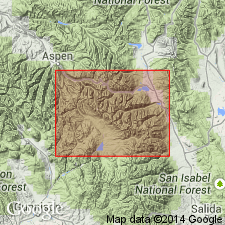
- Usage in publication:
-
- Grottos Granodiorite*
- Modifications:
-
- Named
- Mapped 1:50k (Pitkin Co, CO)
- Dominant lithology:
-
- Granodiorite
- Granite
- Tonalite
- AAPG geologic province:
-
- Southern Rocky Mountain region
Summary:
Named for exposures along Roaring Fork River, at and below The Grottos, on steep, south-facing slopes of Smuggler Mountain and northeast-facing slopes of New York Peak, Pitkin Co, CO (Southern Rocky Mountain region). The Grottos is designated as the type area. Is Middle Proterozoic formation mapped in northwestern part of study area and extends north beyond map area into Hunter and Fryingpan Creek drainages and to west, beneath Phanerozoic rocks toward Castle Creek. Unit described as medium tan to grayish tan, medium to coarse-grained, equigranular biotite tonalite to granite, averages as granodiorite; contains magnetite and sphene. Intrudes schist and metasedimentary gneiss unit (Early Proterozoic) and St. Kevin Granite (Middle Proterozoic). Contains separately mapped leucocratic bodies and mafic border units. Leucocratic unit is light tan to creamy tan, fine- to medium-grained, equigranular biotite-muscovite granite. Mafic border unit is dark greenish gray to dark gray and tan, medium-grained biotite monzodiorite and tonalite. Older than St. Kevin Granite; correlates in part with Middle Proterozoic granite of Taylor River, part of Early or Middle Proterozoic Browns Pass Granite and granodiorite of Sayers; younger than Early Proterozoic intrusive rocks. Age based on undeformed nature of unit, chemical similarity to known 1400-Ma plutons in CO, and because unit cuts St. Kevin.
Source: GNU records (USGS DDS-6; Denver GNULEX).
For more information, please contact Nancy Stamm, Geologic Names Committee Secretary.
Asterisk (*) indicates published by U.S. Geological Survey authors.
"No current usage" (†) implies that a name has been abandoned or has fallen into disuse. Former usage and, if known, replacement name given in parentheses ( ).
Slash (/) indicates name conflicts with nomenclatural guidelines (CSN, 1933; ACSN, 1961, 1970; NACSN, 1983, 2005, 2021). May be explained within brackets ([ ]).

